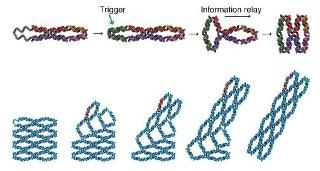Jun 23 2017
Biomedical Engineers have developed simple machines out of DNA, consisting of arrays whose units switch reversibly between two types of shapes.
 DNA arrays change shape in response to an external trigger. (CREDIT - Yonggang Ke)
DNA arrays change shape in response to an external trigger. (CREDIT - Yonggang Ke)
The Inventors of the arrays say they could be harnessed to make nanotech amplifiers or sensors. They could potentially be combined to form logic gates, the parts of a molecular computer.
The arrays' properties will soon be published online by Science.
The DNA machines can relay discrete bits of data through space or strengthen a signal, says Senior Author Yonggang Ke, PhD, an Assistant Professor in the Wallace H. Coulter Department of Biomedical Engineering at Georgia Tech and Emory.
In the field of DNA-based computing, the DNA contains the information, but the molecules are floating around in solution. What's new here is that we are linking the parts together in a physical machine.
Yonggang Ke, PhD, Senior Author and Assistant Professor in the Wallace H. Coulter Department of Biomedical Engineering at Georgia Tech and Emory
Likewise, a number of laboratories have already made nanotech machines such as walkers and tweezers out of DNA. Ke says his team's work with DNA arrays provides insight on how to construct structures with more complex, dynamic behaviors.
The arrays' structures look like accordion-style retractable security gates. Extending or contracting one unit pushes adjacent units to alter shape as well, working like a domino cascade whose tiles are linked.
The arrays' units obtain their stability from the energy derived when DNA double helices stack up. To be stable, the units' four segments can align as pairs alongside each other in two different orientations. By omitting one strand of the DNA at the edge of an array, the Researchers create an external trigger. When that strand is integrated, it squeezes the edge unit into altering shape.
The team used atomic force microscopy to visualize the DNA arrays. They constructed rectangular 11 x 4 and 11 x 7 arrays, included trigger strands and could monitor the cascade propagate from the corner unit to the rest of the array.
The arrays' cascades can be halted or resumed at designated locations by adding break points into the arrays. The units' shape conversions are controlled by temperature or chemical denaturants.
For reference, the rectangular arrays measure about 50 nm in width and a few hundred nanometers in length - slightly smaller than an influenza virion or HIV.
To construct the DNA array structures, the Researchers used both origami (folding one long "scaffold" strand with numerous "staple" strands) and modular brick methods. Both types of arrays self-assemble through DNA strands locating their complimentary strands in solution. The origami method resulted in more stable structures in conditions of extreme temperature or denaturant.
In the Science paper, the Researchers describe that they could construct tubes and rectangles of array units. They also include a cuboid that has three standard conformations, more than the 2D array units with two conformations. Ke says currently his team is developing on larger, more complex machines with 3D shapes, which can be built using the same simple design principles.